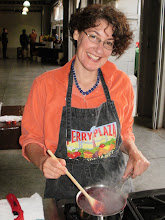Winter kept us warm, covering
Earth in forgetful snow, feeding
A little life with dried tubers.
--T.S. Eliot, "The Wasteland"
After months of mellow comfort in the kitchen, slow roasting and braising to tease out the long-held sweetness of gnarly roots and tubers, spring arrives with a shock. It's the tremor of a chill breeze clattering through new green leaves, lifting the hair on your arms, racing between warm sun one day and scudding wind and clouds the next. So it goes in the garden and the market, as green shoots unfurl and bittersweet is the flavor of the hour.
Much is made of the new sweetness of baby fruits and vegetables: the sugary finger-long carrots, tiny English peas that pop like candy, crunchy sugar-snap peas, skinny asparagus. Verdant and mild, they taste the way freshly cut grass smells. But sharp and sour are what stir us out of our snug baked-potato dens. From the earthy bitterness of dandelion and the pungent bite of green garlic and spring onions to the puckering astringency of sorrel, spring greens are meant to purge and purify. Literally, in many cases: before hothouse tomatoes and Guatemalan mangoes were available year-round, these vitamin-rich leafy greens arrived just in time to scour metabolisms gone sluggish with starch. Freshly dug roots were steeped for spring tonics; leaves went into salads of all kinds. Not that a little grease didn't go far into making these dishes palatable; one of the most traditional dandelion salads dresses the greens with vinegar and hot bacon fat, with the bacon crumbled over the top. The heat "civilizes" the greens, wilting them down just enough so they seem like food, not weeds. I've done the same thing with warm olive oil and balsamic vinegar, and it's delicious. Chopped and sauteed, dandelion greens can be used much like broccoli rabe; mix with sauteed garlic and a dab of anchovy paste and stir into orechiette. Add fresh ground black pepper and a generous fistful of grated Romano or Parmesan cheese.
Lemony sorrel is called sourgrass for a good reason: the tender green leaves (which look a little like young flat-leaf spinach) are almost too tart to eat raw. Cut thinly into a chiffonade, however, they make a spring-vegetable ragout sparkle. I've scattered sorrel over a bowl of asparagus, favas, and fresh peas, pureed it with chicken stock and a glass of white wine to make a quick and elegant soup, mixed it into a frittata. Be warned, though: there is no way to cook sorrel without that lovely bright-green color turning a dull, mucky khaki. The flavor remains; only the prettiness fades.
Every year, I get excited by the fleeting appearance of fava beans, and every year, after a few bagsful, I wonder if they're really worth the trouble. Favas have got to be one of the most labor-intensive vegetables, double-bagged first in thick, foamy green pods and then in sealed white wrappers, both of which need to be laboriously removed before getting down to the sweet, nutty green legume itself. The big pod is always shucked off (although in Italy, very young and tender pods are often cut up and cooked along with the beans); whether or not to slit the thin white pods sealed around each bean is a matter of contention. The pods are bitter, and can be tough; pinching them off is an endless pain, but the reward is unmitigated fava bliss. Smooth and nutty, mashed favas make a delectable crostini topping (add a spritz of lemon juice and a few curls of dry Jack or salty, sheeps-milk pecorino cheese). Whole, they're wonderful tossed into any spring-vegetable saute, especially with a sprinkle of minced garlic chives and a few dollops of creme fraiche or fromage blanc.
Like tumultuous high-water rivers after a spring thaw, April's harvest has its dangers, too. Rhubarb's leaves and roots are poisonous; picked with bare hands, stinging nettles prick and leave a rash; the wrong wild mushroom can be fatal. But I can't help lifting out bunches of nettles (with tongs) when I pass the Star Route Farms stand. Cooked, the nettles taste like an earthier spinach, without that slightly metallic tang. I like them for their weirdness, for the strangeness of turning a toxic, intrusive weed into an edible comestible. Rhubarb stalks are irresistibly pink; raw, they're juicy and very, very sour. I can eat lemons straight, but rhubarb has to be cooked, steamed or baked with raw sugar into a slippery, melodious fruitiness perfectly balanced between tart and sweet. Paired with the first strawberries for pies, compotes, and jam, they match sweet with sour, baby pink and rosy red.
Looking over a unidentified pile of Asian greens at the farmer's market a couple of weeks ago, I asked the woman next me what she used them for. "Very good if you are sad," she said, busily cramming bunches into a pink plastic bag. Spring is like that: with a blast and bite, it wakes you up.
Subscribe to:
Post Comments (Atom)

No comments:
Post a Comment